Dear Friends of YIP,
Greetings from Ytterjärna in full bloom! As midsummer approaches, we at YIP are entering our final week of YIP14. So much has happened since the yippies returned from their learning placements, including six days of canoeing through Swedish nature together before we wrap up the year (more on this in the upcoming newsletter).
This newsletter will cover how life at YIP looked throughout the month of May during their self-designed curriculum (SDC), where the role of a yippie transitioned from participant to organizer, envisioning, planning, and hosting themselves and each other in a time where the structure of every day was up to each individual. Not only was the group engaging with their personal initiative projects, the weeks were also packed with group activities such as movement, singing, dancing, painting, building, and many other creative initiatives. Throughout the year, the participants have been developing a question, theme or project that inspires, challenges and excites them.
This final YIP module was full of activity with many initiatives that came to life both individually and collaboratively.
by Bianca Montemarano
In this newsletter you will find:
- Self-designed curriculum by Elisa Frevel
- Group activities from the self-designed curriculum by Ella Smalley
- instant noodle river by Tuesday Wulterkens
- How might the uncharted parts of my brain help me in the healing I would like to offer the world? by Matara Scott
- A Rehearsal for a Revolution by Marlene Likar
- Not an Oasis Game by Lia Gönner
- Each Yippie’s presentation title and name
- YIP15 Update

The Self-Designed Curriculum
I was really looking forward to the self-designed curriculum in YIP. During these five weeks, we got the opportunity to self-design our own curriculum to suit our personal needs, interests and projects. It was up to us whether we wanted to explore individually or more through group activities. We had a lot of freedom and came together as a group during the meals and the community meeting, plus some other rhythms we cared for throughout the program. So we had a minimum structure for a wideness of freedom. Throughout the weeks, the weather was still cold sometimes, but we also had a lot of sunshine mixed with rainy days, rainbows and wind. The weather could also be seen as how the weeks were, filled with many different aspects. There is such a wide variety in the group that it is difficult to outline what we did, but we all were swamped in personal ways. Everyone had their own individual experience throughout this block, and there were also many beautiful group activities where we shared this involvement together. To give a glimpse into what we did, we organized communal lunches for ourselves for different reasons. We often had fresh salad, soup and bread with delicious bread spreads. Not to forget, we also had terrific fermented food, which came out of another initiative. We had a lot of joy preparing and self-organizing it, and it was a new opportunity to interact with each other.
Besides that, we had courses where we invited contributors to teach us more about topics and answer questions we carry. The courses were very open, and we could freely decide if we wanted to join them or not. That was sometimes easier, and sometimes it also challenged our sense of what we wanted to prioritize and where we needed to accept some feelings of FOMO (fear of missing out). In one course, which we all appreciated, we learned, for example, about fertility awareness, holistic health, intimacy and earthing. We opened taboo topics to have conversations about. Another course was about music, including singing together and improvising in different ways. For me, this block was a lot about trying out, tasting new things and finding more of my own interests. Since there was so much going on at the same time, I also had my struggles in finding myself focusing on what I was doing because I wanted to do too many different things at the same time. It helped me a lot to make a plan during the weekend for having an overview of the coming week. I tried not to be too structured, but to still have some rhythms and structured elements.
These weeks allowed us to learn more about finding a balance between being active and resting. If I put words in a Jam Jar, I would write; wildness, freedom, responsibility, springlike, struggles and a lot of different weather filled with moments of magic. But obviously, everyone would fill jam jars with different ingredients. So let’s do a beautiful jam together. I am very grateful for this time, especially because of all the lovely people!
by Elisa Frevel
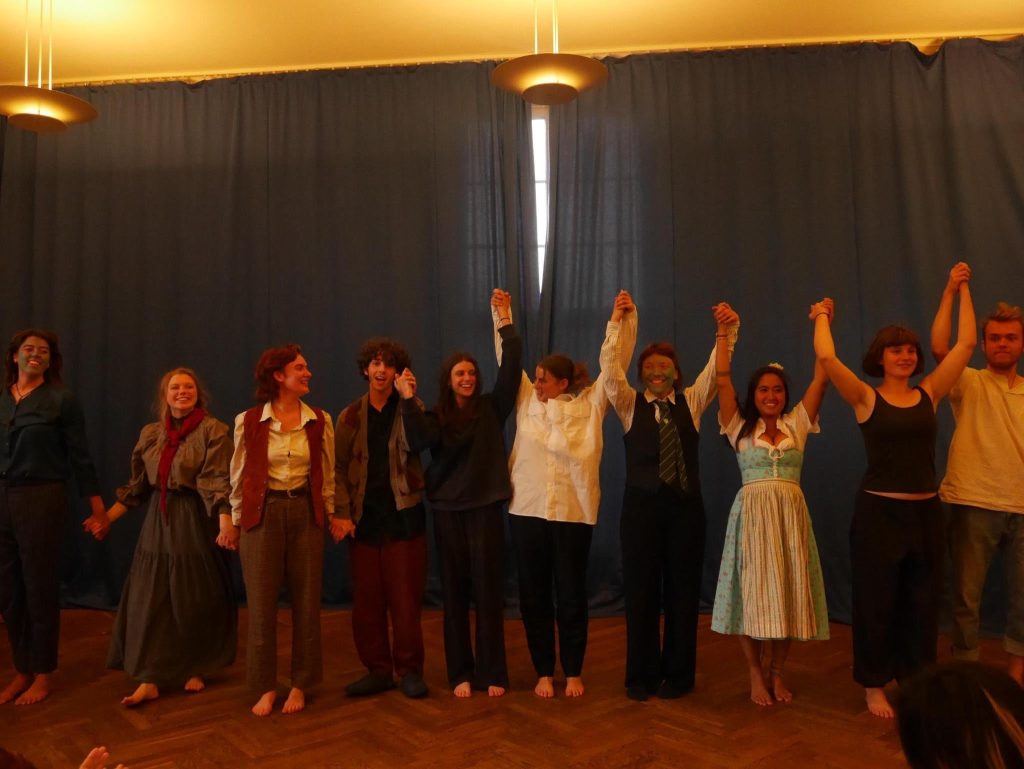
Group Activities from the Self-Designed Curriculum
During the Self Designed Curriculum, we were given the opportunity to explore a question that grew into a personal project for each of us to follow. Throughout the five weeks, there was a great deal of co-creating and innovating going on, that finalised into a week of presentations and performances during the last week of May. It was a time of intense vulnerability, overwhelm and pressure. Yet, it was also a time that grew us closer together as a community, as we could see each other in a different light and we could form more honest relationships based on our own needs.
A large number of the initiatives needed others from the group to sign up to and join. There were daily movement sessions, storytelling photo shoots, magical days of music and singing, a film, a theatre play, a dance, a ‘not an oasis game’ and many more projects. This made it incredibly difficult to know how to juggle your time, as there was so much happening at once. In the first week, I decided to be a part of the dance, created by the talented Carlotta, and the theatre play, formed by the lovely directors, Marlene and Maya. This meant that I had rehearsals every day of the week for the latter half of the Self Designed Curriculum.
For the dance, the process was a challenging one as the group had a myriad of complications to manage, like physical injuries and mental constraints that made you question whether you could do it. In spite of the struggles, the outcome was such a special one that I will treasure for many years to come, as we all came together to showcase a beautiful piece that brought us all so much joy. Looking back, I have had a chance to reflect on the journey and it makes me appreciate the fellow dancers so much more and of course Carlotta, who helped bring it all together. For the theatre, it was a time of much laughter but also a lot of confusion and stress. The theatrical work was split into 10 scenes from different plays, which meant that we didn’t connect as a whole cast very often. The first time that we did come together as a whole team was on the day of the performance, at the dress rehearsal…! However, the admiration I had of the others was enhanced by watching their scenes and seeing how much emotion each actor put into their words and actions. The feeling of elation we felt as a group after we performed was amazing to witness and I am very grateful to have been a part of it.
The week of presentations meant so much to me as it solidified the reason why I came to YIP. At the end of the day, it is the people that make the experience. Seeing each and every one of YIP14 step up to the stage to give an insight into their own personal stories was an emotional rollercoaster with a multitude of feelings like wonderment and awe, and it made me love everyone that much more.
by Ella Smalley

instant noodle river
To take initiative or not to take initiative, that’s the question. Among others, too many sometimes. Maybe a little bit or not? Who am I and who am I doing this for? Why do I wake up in the morning? What are the stories I tell myself? What are the stories from other places and other people? What is a single story? How does a single story work? What are single stories in your head? What do I think about people from Norway, or ballerinas? What does it mean to understand someone? Put your shoes on. Why do we not understand each other? And why does it feel like we deliberately try to not understand each other? Can comedy solve problems, or writing, or theater? Seriously put your shoes on. What is love? What do I love? Do I love storytelling or theater? Is theatre not a form of storytelling? How can I support others? Brush your teeth. How can I create love? How do I deal with the darker parts of life, the ones that bring me shivers? How do I build resilience? Drink coffee. How do I build up understanding, love and resilience through storytelling?
Okay, you have a question, now what? More coffee? And a cigarette, maybe. Taking a leap of faith, walking on loose boards. Taking risks. How to reach more people? How to create a bigger audience while stuck here in the middle of nowhere? I don’t want to go inside myself. I love movement, change, fast cities and traffic jams. I hate diaries. How do I support others? Time management. Another thing I’m not good at. Theatre plays, laundry, shooting photos. I try to grasp a moment to breathe, to actually look at what I’m doing, but maybe that’s not the point. Maybe my impatience and unstructured behavior is a gift. When you feel something inside you that is burning, like a fire, bigger and bigger. I’ve never felt this need to do something. Something big, something that will change the minds of friends and foes, something that is beyond the stories we tell ourselves.
In the end what will prevail is your passion not your tale. I made a night, a few I think. Where people came together and celebrated their tales, their differences and things unknown and far away. I didn’t change the moon or the stars but in the end we all made things of beauty and wonder and loved each other more deeply, or at least I did. I’ve worked with people, shared some frustrations and found the meaning of service or motivation. Something shifted. Outside in or inside out? I’ve found a place to put my past, my thoughts and journeys. In writings, strange ones. About unnecessary obligations and yellow taxis jumping sky high, never to return to earth. About starry nights and elegant yet arrogant skyscrapers. All because of some questions and the encouragement of others. And for that, I couldn’t be more grateful.
What’s next is more initiative, that is not a question any longer. I am willing to try my best and to help others. I want to tell you stories, I want to make you wonder. To derail you, to excite you. I want to create love. I love you.
by Tuesday Wulterkens
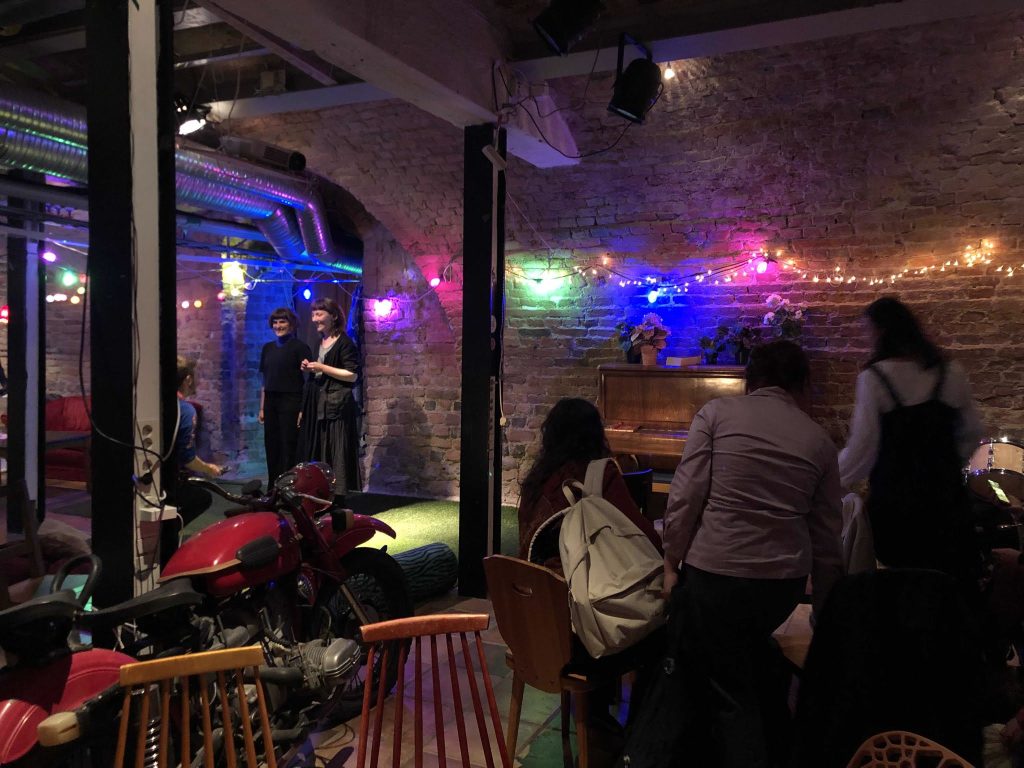

How might the unchartered parts of my brain help me in the healing I would like to offer the world?
“Close your eyes. Straighten your back. Scan your body. Focus on your breath. Sink in. Relax.” The audience lay scattered on the wooden floor of the elegant Vita Huset ready to be lead through a guided meditation. Yet, whilst leading this process, my own nerves were bubbling for the rest of my presentation. I felt comfortable in this space of leading meditation, this is what I had practised doing, but then to spend 20 minutes talking about it was a whole different story. But maybe that was the point of my personal initiative – to remain calm even when life challenges you. That is essentially what I had been exploring for the past 5 weeks, how meditation can anchor me in the present moment during the unpredictability of life. I explored the question: ‘How might the unchartered parts of my mind help me in the healing I would like to offer the world?’
YIP for me has been an intense and rich experience. It has been almost essential for me to have a personal practise to stay sane when life got full. So during the year I practised. Most mornings were spent in the library for one hour, truly giving myself the gift of alone time and the freedom that came with that grounding. It has allowed me to spend my day surrounded by others, whilst staying true to myself and feeling connected to my own needs. It meant I could be present in community.
Then reflecting on the initiative part, I invited others into that practise every Wednesday evening at 8 o’clock. But instead of suggesting that everyone should engage in meditation, I wanted people to know that mindfulness can be found in any part of your life. It might be your meditation to run, or to observe the view out of your window every morning. I hope that everyone can find their own practise, one that roots them in the joy of the now.
“Close your eyes. Straighten your back. Scan your body. Focus on your breath. Sink in. Relax.”
by Matara Scott
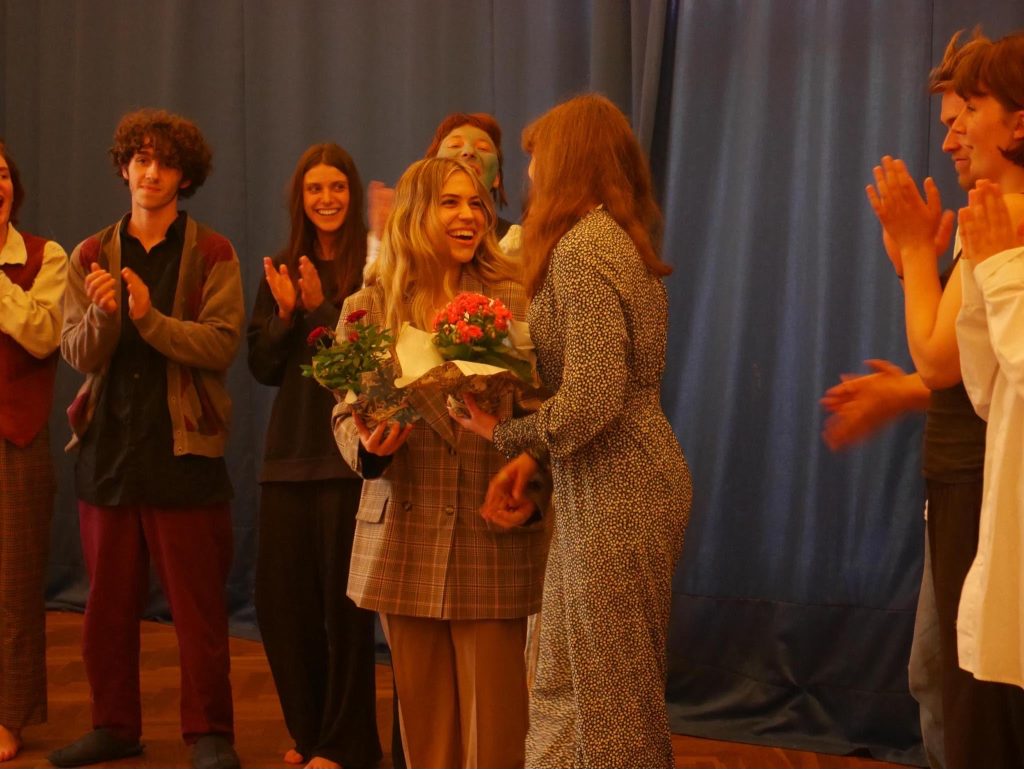
A Rehearsal for a Revolution
Start: Idea – Manifestation
“I never understood why in this society, in the world, on this planet are so many conflicts happening which only arise from misunderstandings, apathy, egoism and a limited worldview. I have never understood why we as humans have such difficulties coming together and why we cannot instead of working against each other, collaborate and in exchange work together. Instead of badmouthing the other person for being different, try to show empathy for them and their view of the world, or at least try to accept the person for who they are, even if it is difficult to understand them fully. No? And I don’t want to set up a non-violent communication workshop here, even though that is of course a helpful technique to help people deal with each other in a more non-violent way. But no, I’m trying to approach this from a different perspective.”
This is how I explained to Liam what my motivation and my urge is behind my personal initiative. He looked at me with a smile on his face. “I want to do it differently, I want to approach it in a playful way,” I said. And so, my mind started spinning. Should I maybe develop a game, interview people, ask them about their biggest conflicts and then help them to solve those? Or develop a theatre play? After the almost 2-hour interview with Liam and of course several other conversations with friends and family, I came to the conclusion that I want to create a theatre performance. A play that deals with the topic of conflict resolution. From this idea the research question developed: How can I inspire other people, through a theatre play, to create more safe places, where people feel understood, connected, respected and genuine towards each other?
My expectation and plan was to search for scenes which mainly incorporate the topic of conflict and then, to merge them into other scenes which hold the topic of conflict resolution. I thought that is the only way to provoke the audience and trigger them to start thinking about their actions – and through this, reach the goal of my research question. But after a while, I realized that in order to achieve my goal, I don’t have to pursue such an obvious path. I don’t necessarily have to present to people exactly what change I want to see in the world. I don’t have to hold a lecture about conflict resolution, I don’t have to tell people, I have to walk my own talk. A quote from Augusto Boal perfectly sums this up: “It is not the place of the theatre to show the correct path, but only to offer the means by which all possible paths may be examined.”
I started to look at the project from a different perspective and saw that making a theatre play in itself, already offers a space to bring people together. Because the way I wanted to realize my project was through collaboration. I wanted it to be a project in which everyone would be given the space to manifest their ideas, to be as creative as possible and above all not to perform for anyone else but themselves. In the means of collaboration, I worked with Maya on this performance together. She had a similar dream to me, of directing a theatre play and so we decided to work in cooperation as directors.
Process:
After consideration, we agreed that our performance would consist of various scenes from different plays which examine a diversity of meaningful, thematic concern. We thus began our process of collating various scenes from plays we admire. From: The Glass Menagerie, Monster, Little Women, Waiting for Godot, Death of a Salesman. Furthermore, we discussed and organized the order of the scenes. Additionally, Maya decided that it would be meaningful for me to re-write various scenes and parts of scenes to better complement our context.
Our next phase of execution was to host two open meetings to invite potential actors, actresses and creative collaborators. After we had the various roles signed up for, we started the actual rehearsal process. Starting from 4 hours a week, to rehearsing every day. Maya and I met additionally – outside of rehearsal times. We also spent time reflecting on the process thus far – pondering our overall next steps and checking in with each other around the questions we held.
We experienced many highs and lows regarding the rehearsal process. One of our main challenges was in the issue of time management. Both for the actors and for us. Juggling time around all the various initiatives, both personal and collaborative – that our actors were involved in, was a challenge. We personally struggled with the planning of adequate time for rehearsals. We faced a notable challenge in finding the balance between when do we say too much or not enough? What is efficient feedback? When do we leave the interpretation of text and characterization completely up to the authentic experience of the actor? When do we impart our vision onto this process?
Outcome:
This project proved to me once again how art, and especially theatre, can communicate so much to the audience, but above all to the actors themselves. I stepped into the role of the director this time. I was of course able to look at it from a completely different perspective. To experience these wonderful people who were so courageous to take on a role, witnessing them in their fullest power, on their bad days and when they were in their most authentic being, was very empowering. It has also definitely trained me in my patience to take a step back, not to always have to take the lead, to leave the creativity free to the others and to trust.
In addition to the obvious high amount of work and the energy you have to put into such a project, one thing has remained very present for me. It has such a power when people work together. It’s just indescribable how much motivation and fun you can get from working together towards a goal. To exchange ideas, to bring different people, bodies, voices and heads to one, can create something so wonderful and special. That is one of my biggest passions. Working in a creative way with as many people towards one goal. It just makes me feel so empowered and gives me so much hope and trust in the world and the people that are in it with me. That is how I believe that change can happen, starting with us working together, in a respectful and genuine way, where voices can be heard and stories be shared, because we don’t need more than just us and our beautiful ideas and unique potentials.
I see drama, in particular, as a beautiful way of expressing various themes in a relatively concise and clear way. In a way that is understandable to everyone. No matter how abstract and absurd the piece may be, after the performance, something will have changed in you. It does not have to be a great new insight, or the biggest realization you ever had, but in any case, at least one feeling or a sensation will have arisen and that is the whole point of the art behind it. It is the most human thing you can do. Everyone knows how to play and everyone understands it.
“We are all actors: being citizen is not living in society, it is changing it.” – Augusto Boal
The moments of laughter we shared with you, to your spectacular moments of creative catharsis, it has all made this time so extremely memorable and remarkable. It has certainly left an indelible impression on us, that will remain far longer than this fleeting experience itself. To each and every one of you involved – we are so very grateful.
Personal:
Theatre also has a very personal meaning for me. Since my father is a film director and my mother a musician, I have always been surrounded by art from various fields. And if theatre didn’t exist, I probably wouldn’t be standing here either. Yes, my parents met at a theatre production in my hometown. Why the topic of conflict is so significant for me, well it probably is for many, as it is relatively present in today’s world, but on a personal level and also in my life, is because I have very often found myself in the position between conflicts, starting in my childhood when my parents separated, to conflicts between two friends of mine, me in between, and I was also often called in at school to mediate arguments.
by Marlene Likar
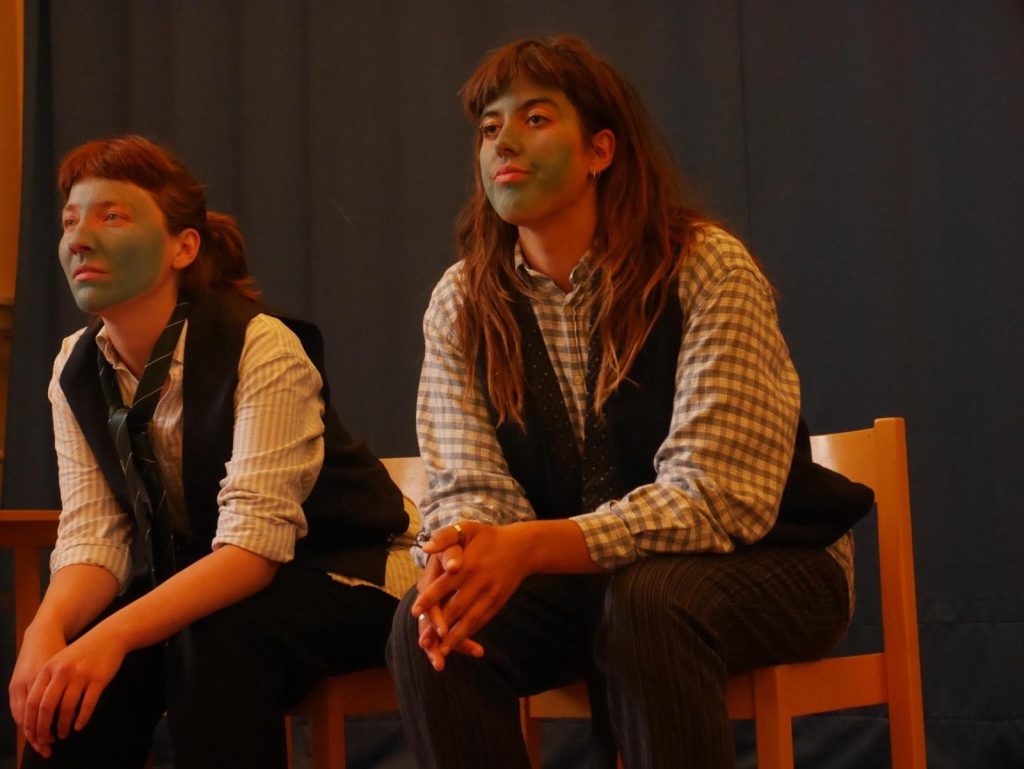
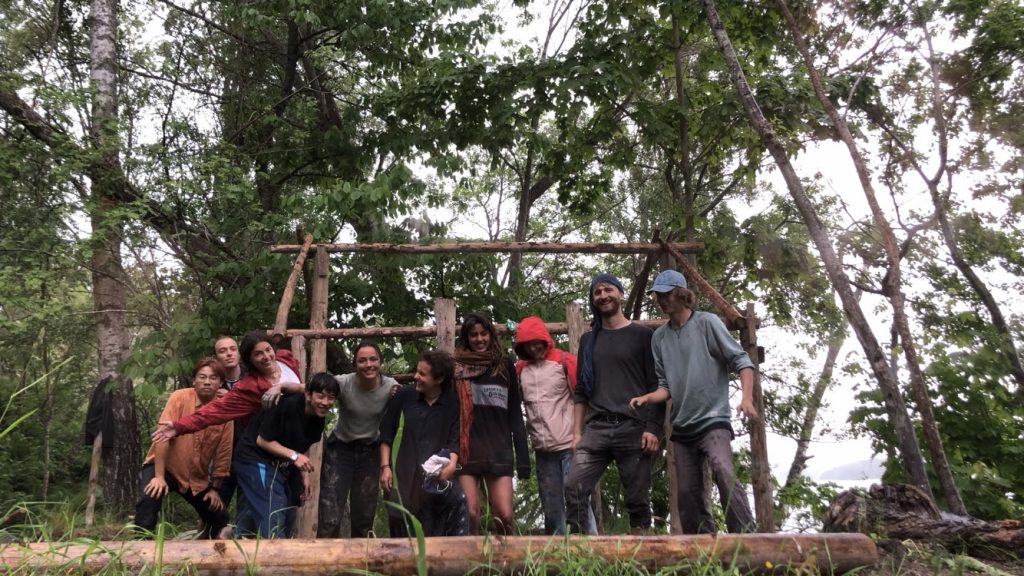
Not an Oasis Game?
A few days before the Personal Initiative presentations, my stomach turned around when I just thought about it.
How should I present something which is not finished?
But let’s start at the beginning.
WhAt DoeS ArT TeAch Us AbOUt OuRSelves?
When we had the portrait painting week, that was the question which came up when I observed other people and the emotions coming up through that process.
So, I started talking to other people about art and their epiphanies and reflections. Dajin, a Yippie, wrote a wonderful review that greatly inspired me.
“It was surprising that others can discover the things I can not find out. And I felt the same thing happens in life, not only in the painting process. We need each other’s eyes to see wide.”
It reminded me of a philosophy from Rudolf Steiner: The 12 perspectives.
This theory discusses the different approaches to how people can perceive or experience reality. All the 12 perspectives are equal and enable, when they come all together, a way to get closer to the understanding of reality, the world we live in.
So, why are the 12 perspectives important if we look at the global, macro-level of society? If there is a diversity of views, it always means that there is a dynamic, never ending process. In the context of society, our individuality brings dynamic movement.
HoW DO We CrEaTe A sTrUcTurE WhICh AdaPTs To ThE DyNamIc ChaRaCter Of soCiety?
I took this question as a lens and looked at the process of making art/creating paintings.
If you paint and correct something with your brush or pen, you take a step back to look at what you have corrected. Now the whole picture is a bit different than before. Did the change of one part affect the other parts? Probably. So, now you correct the other parts of the painting, take a step back and so on. Concerning societal structures, that means: In order to have societal structures & economy that can serve our lives, it has to be observed and adjusted or improved all the time. And that feeds again into establishing a dynamic system which involves the 12 perspectives.
HoW CAn We DEvelOp A sPaCe wHerE The Exchange Of persPectIveS Is iN ThE fOcuS aNd is oPen SouRcEd?
Another interest I hold is economics and art, architecture and design.
HoW dO wE dESign oUr sUrrouNdinG In oRder tO creAte tHe CiRcumsTances foR hoW wE liVe?
HOw dOes ArchItecTurE inFluenCe Us anD HoW dO wE inFluEnce arChiteCture?
So there were a lot of questions. But they were all intellectually based and not connected to a need within myself. So I sat down and reflected on myself. What I found out was that I was so interested in the 12 perspectives because everyone is equally seen. Every perspective is needed, and so is mine.
I had struggles growing up, being taken seriously while being an artist, thinking through pictures and colours. I didn’t feel that in the realm of social change, there was a space for art or that art was able to actively do anything. Art felt like it was not the advance force of realizing social change.
After talking to a couple of people about my personal initiative, my plan was to develop a platform/project inviting perspectives of people in their diversity. And that project would be to create a place with people together in nature.
As a prerequisite for this project to be realized, I developed three questions.
The first one is about about the relationship to nature:
hOw cAn wE bE hUmaN, aCknOwledGe thE bEauTy oF oUr eXisTance anD aT tHe sAme TimE AcKnOwlEdge The bEauty Of NatUrE sO thAt BotH humAns aNd nAturE caN thRive?
The second question is about the relationship to space:
CaN a SpaCe hOld ThE dIverSitY oF pErspecTiveS eXistIng wiThin tHe liVes Of HumaNS aND thEir NeEds?
And the third question is about the relationship to people, to community:
HoW cAn wE liVe iN a poSitiVe inTerdePenDency?
So now, I had three questions but still not the one question of my personal initiative. After a “flow game” we did in YIP, I finally found out my question:
HOW CAN MY PERSPECTIVE HAVE A POSITIVE IMPACT AMONGST OTHER PERSPECTIVES IN ORDER TO MOVE OR CHANGE SOMETHING?
To connect the people to the project, see what their needs are and harvest a collective vision of what the place can look like, I asked a couple of people some questions. I asked them about their visions and dreams and called them Mosaik visions.
In April and March, we all went on learning placements and had presentations about them. A group went to Brazil and did an Oasis Game. An Oasis Game is a concept which allows people to collectively realize their visions. People come together at a place, speak to the community, and understand and listen to the needs of this community. Based on that, a collective vision is going to be developed. That vision could be to bring colour into a space, create a communal space, etc… And then, in a short amount of time, with collective effort, you realize the vision. Then, after you have finished it, it is time for a celebration. And then, you ask the question, what comes next.
This concept fascinated me, especially in the realm of social change. It brought the creative process and social change together. So, I decided spontaneously to do it similar to the concept of an Oasis Game.
Now the Self-designed curriculum came. I will sum up that time a little bit. I sat with people, introduced the overall vision, and we started to prepare, carry, shovel, and clean up. In the first week, we managed to make the foundation of the planned little hut. Then, we cleaned the space called “the rave spot”, a meadow at the waterside where in the past, a bunker was standing. We got wooden pillars from Martin, a man who owns the sawmill nearby. He even lent us a chainsaw and trusted us to saw the pillars to the right length.
And then the fourth week came. I got sick, and everything sort of just stopped. It was challenging for me to still trust in the Oasis Game working out. More and more initiatives took place now and made it difficult to find the time and hands needed for the Oasis Game.
We did a joint notebook-making session. Because I knew how to make sketchbooks, I taught how to do it. It is pretty tricky. Some people were quite frustrated, some were very much in their own world, and some were very enthusiastic. Simply said, it was creative chaos. This chaos reminded me why I want to work together with people in a creative process. In the end, everyone had a finished sketchbook and were quite amazed by the fact that they did it themselves.
Now, back to the Oasis Game. In the fifth week, I managed to saw with some people the wooden connections for the different pillars. Then, the week was again quite full. Things were shifting, and my motivation sank and sank. When I talked to another Yippie, Simon, about people not showing up and everything not working out, he said, “Let’s do it.” So, with Reinoud, an OT’s help, we brought the wooden pillars from the Sawmill close to the rave spot. Now we just had to carry them the last ten minutes. But with only three people, 16 wooden pillars of two to three meters was pretty heavy. Simon now got the idea to let them float on the water along the coast. So we took our pants off and tried to carry them in the very cold water. After one hour, moving twenty meters, we gave up and ate dinner. After dinner, we bound them to canoes to carry them to the rave spot. And it finally worked out. I was exhausted, but happy. This day was the Thursday of the last week of the Self-designed curriculum. Everybody was completely focused on their presentations, and I knew that that’s how far I came with my personal initiative. So I also started to prepare my presentation and reflected on the whole process.
HoW dO yOu pResnT sOmeThinG wHicH iS not fInIShed?
I was very conflicted within myself. On one side, I saw the process of the Oasis Game taking place. I saw the struggle and learnings I gained out of that. I did have the opinion that the process is often underestimated in relation to the outcome. But on the other hand, I felt I was not looking the failure of the Oasis Game in the eye. I felt I was sugarcoating it. But then I came to the conclusion that if I acknowledge the process, it is part of moving towards a dynamic societal structure. Failure implements an ending. And an ending denies the possibility of further movement. But we need constant movement to adapt to this world.
In the creative process, there are always ups and downs and downs of things working out or not. For me, this process was always hidden, done by myself. Now it was open for everybody to observe. And with that, I felt quite vulnerable. I had to build up trust. In myself, in the process, in other people. I think that is one of my biggest challenges, still. Two things I learned were that first, you always need more time for collaborative or creative projects than you think. Then, if things are prepared properly, you provide the best circumstances for actual creativity and collaboration to take place.
Back to my question:
Ho caN mY PerSpeCtiVe HaVe a pOsiTive ImpAct iN oRdeR tO mOvE oR cHanGe SomEthing?
I didn’t figure out the answer. And that is good because I am still carrying it very close to my heart, and it keeps me curious about the positive impact people have on the momentum and process of change. But I saw many people in a way I didn’t notice before. I saw everything working out in those ways because of the different ways people answer questions and problems. It taught me a lot about the sentence Reinoud quoted: “How can I be for you to be free.”
If people are taken for who they are, if they are taken seriously, they trust themselves and stand in and for who they are. If I trust in myself, I can provide my perspective to others. Ideas are then brought together. Trust is the glue of our relationships, and they are the glue of our society.
Then I did my presentation. And what came out of it was beautiful. People didn’t want to let it be unfinished. So, two weeks later, the Oasis Game happened one last time.
I was nervous. But this time, I knew what to prepare and how. Everybody was very motivated—even people who physically couldn’t help, which touched me greatly. We stomped in the mud with our feet, hammered, sawed, carried, listened to music, ate, swam, and got sunburnt and wet from the rain. In the end, I was tired and not capable of decision-making anymore because we had worked the whole day long. But it wasn’t really necessary for me to make decisions. The people got so involved with the project that it was not “my” Oasis Game anymore, but it was instead our project that we built together.
The wooden structure which we built doesn’t have a roof yet. But that doesn’t mean anything about whether things are being finished or not. This place is now for the next generations of Yippies – open for them to build and make their own.
by Lia Gönner
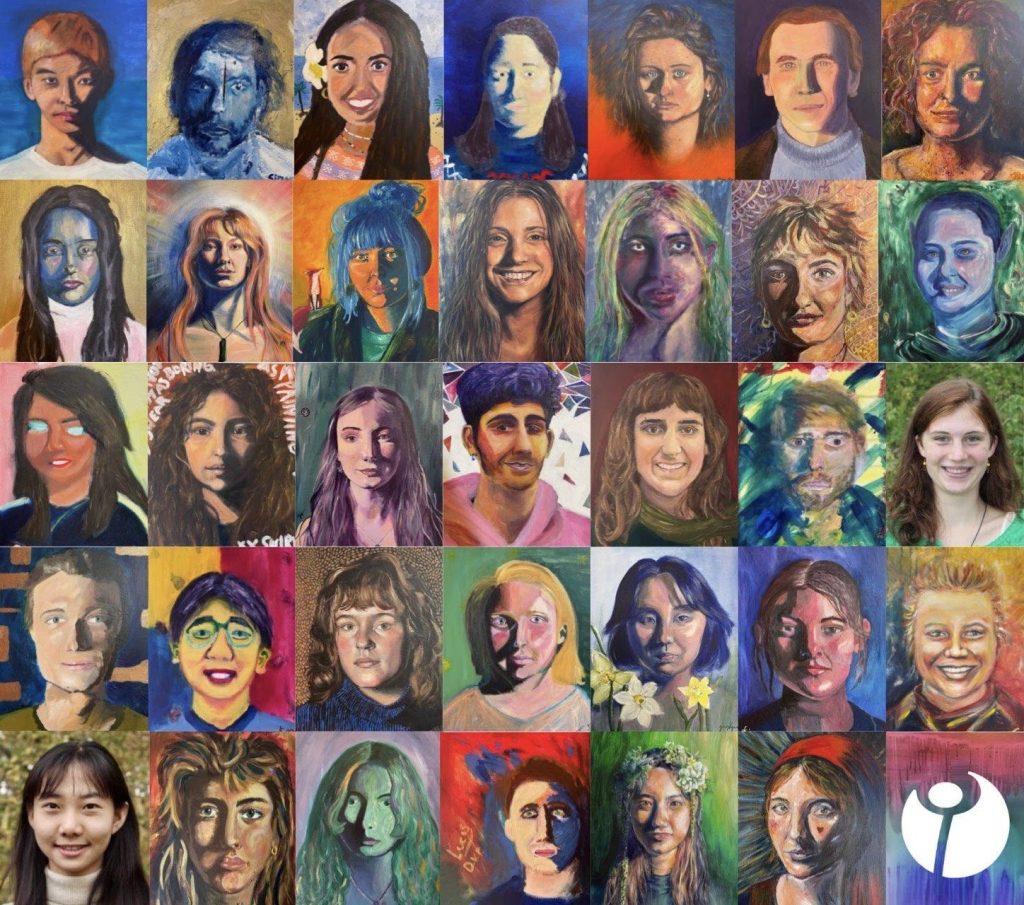
YIP14 Personal Initiatives
instant noodle river – Tuesday Wulterkens
Me & My Daily Rhythm – Elia Annerwall
Health – Christianne Huisman
Ukelele – Kong Wu
“Where are my carrots coming from?” – Elisa Frevel
Song writing – Maxine Alip
Spinning wool – Pippin Ibell
The Virtuous Cycle – Liam Pearson-Moyers
What are you looking at? – May Wyss
The Concept of Reality – Eva Baier
Cut – Julia Vossen
My Metaphors – Junghyun Kim
Making “Beings”- Photographic Fairytales – Iren Barnum
A Year in Songs – Simon Bauke
Growth through collaboration – Ozan Martin
Fermenting into the future – Tessa van Ruitenbeek
Online magazine, flower collect – Dajin Lee
D’answers – choreographing a contemporary dance performance – Carlotta Rosiny
Shirin and YIP – Shirin Milch
Not an Oasis Game – Lia Gönner
A Rehearsal for a Revolution – Maya McIntosh & Marlene Likar
Development of a Community – Vicky Si
The Heart – Ella Smalley
self-designed chaos – Rike Altmann
An attempt at imperfection – Ella Rehin
FOOD!? – Edda Richter
How do we relate to our bodies? – Sara van Dongen
A personal journey towards authenticity – Kato van Goethem
How might the uncharted parts of my mind help me in the healing I would like to offer the world? – Matara Scott
The Meaning of Music – Anika Jensen
Conflict, Peace and Justice – Tazin Akter
Watching films and making films – Yoh Tabata

YIP15 Update
Applications for YIP15 are now closed. Thank you for all of your support in spreading the word about YIP. We are very excited to welcome 40 participants for YIP15.
Love from the Organising Team

